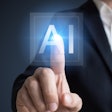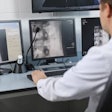Intelligent imaging systems that learn with each scan and produce medical images with unprecedented speed, detail, and precision represent some of the most seismic advances in radiology since the Nobel Prize in Medicine was awarded to the inventors of computer-assisted tomography in 1979.  Kelly Londy of GE HealthCare.
Kelly Londy of GE HealthCare.
AI is revolutionizing medical imaging across every aspect of diagnostic imaging as a triple threat in planning, scanning, and diagnosis. From addressing image quality challenges related to noise and patient movement during scans to optimizing workflow inefficiencies resulting from increasing patient backlogs, staff shortfalls, and clinical expertise shortages, to dealing with today’s inflationary environment of rising healthcare costs and sustainability challenges, AI is destined to redefine what is possible and change outcomes.
Deep learning, a subset of AI, enables computers to use brain-like logical structures of algorithms called artificial neural networks to process data in a way that mimics the human brain’s ability to learn. Just as different body parts work together harmoniously, deep learning integrates various facets of machine learning to create a comprehensive network of information.
This layered approach enables AI-powered imaging technologies to build a detailed snapshot of vast volumes of data, layering images together to fill in gaps that are less defined due to patient movement, breathing, or coughing, which can create missing information or blurred pictures. AI also allows radiologists to more comprehensively analyze medical images to detect subtle anomalies that might be impossible to discern with the human eye.
While better and faster images and scans are the foundation of next-generation MRI, CT, and molecular imaging technology, more can be done to harness the full potential of AI to enhance tissue-based detection and characterization and provide clinical decision support.
Impact across modalities
Across imaging, deep learning is rapidly transforming the radiology landscape, improving the patient experience, reducing human error and automating workflow. The result is better health outcomes and a chance for radiologists to spend more time dedicated to patient interactions and personal care.
AI is not intended to replace the clinician or patient care. However, many in the medical field now see AI as an "intelligent assistant" that can simplify their work, alleviate burnout, enhance operational and clinical efficiencies, and boost diagnostic confidence.
MRI uses powerful magnets and radio-frequency waves to construct detailed pictures of organs, joints, and other soft tissue in the human body. It is the main tool for diagnostic imaging in oncology, neurology, and cardiology. The advantages of MRI are well-documented, including the lack of ionizing radiation, volumetric capabilities, superior soft tissue contrast, and the potential for quantitative imaging.
Unfortunately, long imaging times and a lack of high spatial resolution have historically been common clinical complaints around MRIs. However, with advancements in AI and deep learning today, these innovations have had a huge impact on scans.
Leveraging these innovations in deep learning can help improve image quality, as well as enable scan time reductions. Where there were once limitations when it came to conventional MR image reconstruction, deep learning can be leveraged to help dramatically enhance MRI scanning.
In traditional MR imaging, long scan times can lead to motion artifacts from bodily movements. Deep learning allows scanning speed to match the speed of the human body to improve image quality. It also allows patients with arrhythmias, chronic liver disease, or metastatic disease – who may have breath-holding challenges that could cause movement and make images blurry – to complete exams more quickly and comfortably, while providing sharper, clearer images.
In cardiac imaging, AI in some cases can facilitate the acquisition of MR images up to 12 times faster than conventional methods, enabling cardiac imaging within a single heartbeat. The ability to reduce cardiac MRI scan times has enhanced productivity in radiology departments, streamlining workflows, alleviating backlogs and reducing the burden on staff. AI can automate routine tasks such as image segmentation and measurement, improving provider job satisfaction and reducing radiologist burnout.
Sustainability and access
The transformative nature of AI is not only improving the diagnostic journey of patients and healthcare providers by reducing scan times and maximizing image quality, but it also serves as a key driver toward more sustainable and equitable access to MRI. As deep-learning techniques become more integrated into daily clinical routines, MR systems are utilized more efficiently, reducing power consumption per patient and CO2 emissions per MR scanner per year, thereby relieving healthcare systems of inflated cost pressures and growing backlogs.
In addition, as the population continues to increase and age rapidly, AI delivers the standardization and consistency required to drive population outcomes. The introduction of new care pathways, particularly in oncology and neurology, requires the expansion of MR to new clinical indications for preventive, predictive, and personalized medicine. AI already plays a critical role in the research and development of potential biomarkers, as well as in defining a standardized approach to clinical translation.
A look ahead to planning and diagnosis
In an era where technological innovations are driving advancements across all industries, deep learning is playing a pivotal role in transforming healthcare. As these tools continue to evolve, AI's role will expand beyond imaging scans, extending into planning and diagnosis to enhance care and unlock greater possibilities. By leveraging deep learning, the patient experience can be revolutionized, starting even before the scan takes place. This includes automations in patient scheduling, setup, and the in-bore ambient experience.
After the scan, AI and deep-learning innovations – including generative AI – can be used to help clinicians diagnose diseases more quickly, even in cases involving complex anatomies. Additionally, AI has the potential to assist clinicians in reporting, further streamlining the diagnostic process.
Research into how MRI powered by deep learning can impact the neuroscience space is already underway. Neuroscience, particularly in the study of psychiatric diseases and neurological disorders such as Alzheimer’s disease, has been constrained by technological and biological limitations, leaving many aspects of the brain structure and functionality largely unexplored.
New innovations in this space will provide insight into images and measurements of the brain that weren’t possible to capture before with conventional MRI, helping to enhance the diagnosis, understanding, and treatment of complex diseases. These advancements in AI and deep learning are not just incremental improvements; they represent a paradigm shift in medical imaging. As boundaries of what is possible continue to be pushed, the potential to transform patient care and outcomes grows exponentially. The integration of AI into clinical practice promises to revolutionize the field, making diagnostics faster, more accurate, and more accessible.
The future of imaging is incredibly promising. I am excited to witness how AI and deep learning will further empower clinicians, improve patient care, and unlock new frontiers in medical science.
Kelly Londy is president and CEO of GE HealthCare’s MR business.
The comments and observations expressed are those of the author and do not necessarily reflect the opinions of AuntMinnie.com.



















